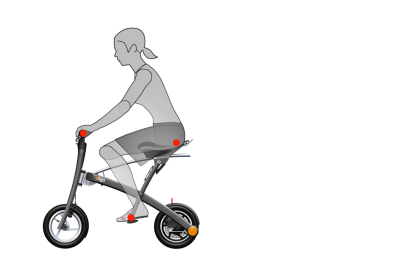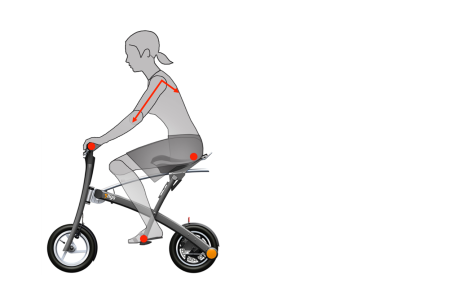Whatsapp Us Today! Join Now

Many people have questioned the unique design of the Stigo and wondered what design considerations went into the Stigo. The Stigo does look quite awkward from the outset, with its low seated position. However, once you have ridden one, the experience will change your mind. The low handlebar height with the broad saddle and the position of the leg rest were all carefully thought out by the Estonian designers of the Stigo.
“The best relaxed position is when the handlebar is on the same level as your saddle. Handlebar cannot be more than 10 cm higher than saddle.”
– Juliane Neuss, German Bicycle Association
The Stigo saddle is unlike any bicycle saddle. In fact, it’s designed to oppose many traditional cycling philosophies. A bicycle seat is designed for fast and efficient pedalling, hence the slimness and streamline structure of the traditional bicycle saddle. Compare the bike saddle and Stigo saddle side by side:
The Stigo is designed specifically to be as comfortable for long distance riding without the need to pedal. The broadness of the Stigo saddle supports more of the buttock which helps to relieve pressure from the soft tissue and organs.
Also the curvature of the Stigo saddle prevents the rider from slipping off on inclines, similar to how bucket seats on a race car keeps the driver from being thrown sideways during turns.
It’s not how heavy the person is but how evenly distributed his weight is! It’s all about weight distribution with the Stigo. The design of the Stigo is such that the rider’s weight is distributed between three supporting points: arms, legs and upper body – this reduces stress to muscles and back. This is the same concept which city bikes are based on.

The muscles are perfectly built to work with the double S-shape, the ideal sitting position. Experts believe that your riding position is supporting the spine when you maintain the S-shape. The Stigo riding position is designed to support the natural S-shaped spine, allowing for even distribution of body weight.
The Stigo riding position also allows for 80-90 degree angle between the arms and the upper body for good load distribution – this reduces the supporting work of shoulder, arm and back muscles.
According to experts, a comfortable relaxed riding position is when the handlebar is not more than 10cm from the saddle level. That maintains the 90 deg angle between arm and body, allowing the body to relax while riding long distances. Again, its all about even distribution of weight between the 3 contact points.

90 degrees arms/body riding position
The Stigo is probably the most well thought-out seated electric scooter/ebike in the market. After all, it has been 5 years in the making and thousands of miles have been put into it since the first prototype.
Test drive the Stigo electric scooter today and experience a higher level of riding comfort.
All orders are shipped in 1-2 business days and arrives within 1 week.
Free Shipping on local orders
Experienced Before and After Sales Support